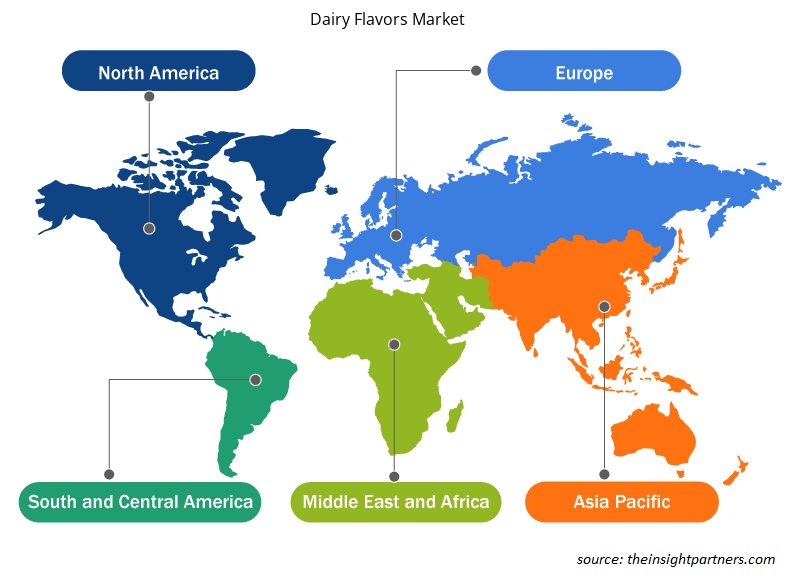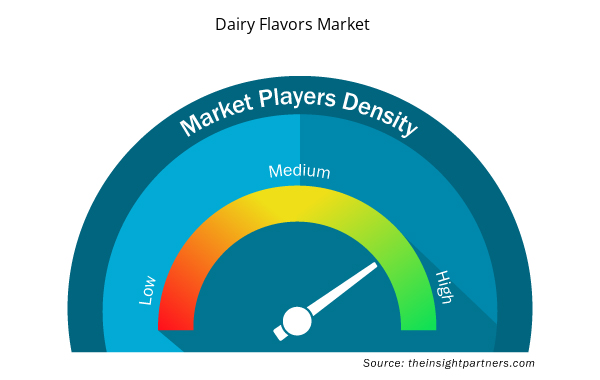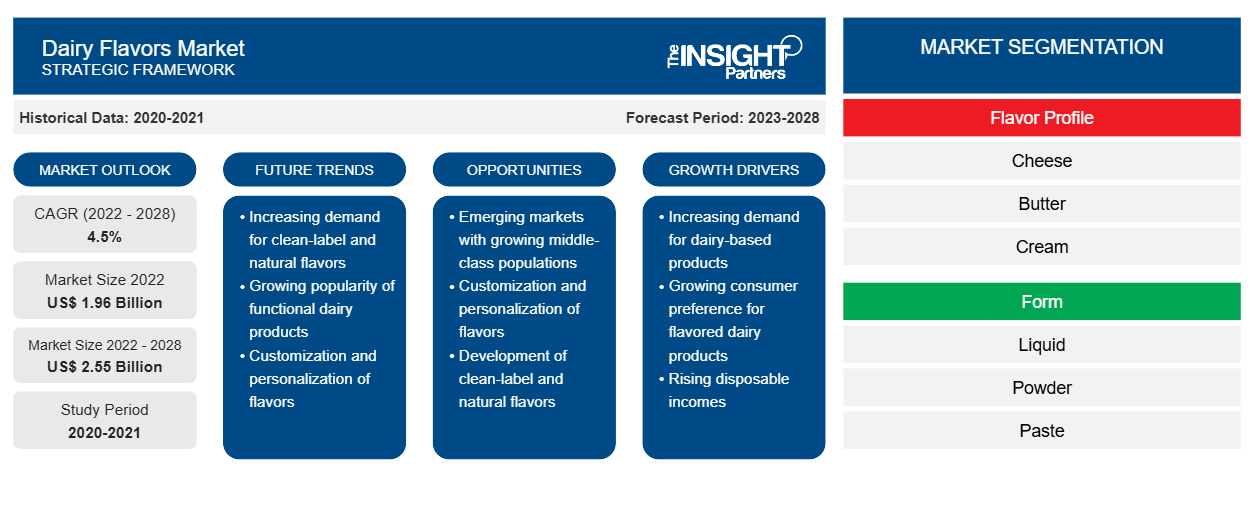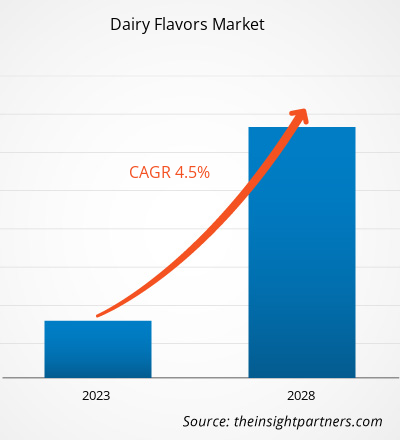Si prevede che il mercato degli aromi ai latticini crescerà da 1.962,45 milioni di dollari nel 2022 a 2.552,19 milioni di dollari entro il 2028; si stima che crescerà a un CAGR del 4,5% dal 2022 al 2028.
Gli aromi lattiero-caseari sono agenti aromatizzanti aggiunti a vari prodotti alimentari e bevande per conferire il sapore di prodotti lattiero-caseari come burro, formaggio, panna e latte. Gli aromi lattiero-caseari stanno guadagnando terreno nel settore alimentare e delle bevande in quanto aiutano a conferire il sapore del latte senza aumentare le calorie o il contenuto di grassi del prodotto. Gli aromi lattiero-caseari sono lavorati e prodotti da prodotti lattiero-caseari come latte, burro, formaggio e panna e sono disponibili in formati liquidi, in polvere e in pasta. Questi aromi sono pensati per esaltare il gusto e l'intensità di vari prodotti alimentari, fornendo loro una serie di profili di sapore come burroso, formaggioso, cremoso e molti altri gusti dolci e salati. Gli aromi lattiero-caseari sono utilizzati in vari prodotti alimentari come prodotti da forno e dolciumi, snack dolci e salati, zuppe e salse, salse e condimenti e dessert surgelati.
Nel 2021, l'Asia Pacifica ha detenuto la quota maggiore del mercato degli aromi caseari e si stima che registrerà il CAGR più elevato durante il periodo di previsione. La crescita del mercato in questa regione è principalmente attribuita alla crescente consapevolezza della salute e alla crescente attenzione per il cibo gustoso in paesi come India, Cina e Giappone a causa dei crescenti redditi disponibili. I consumatori sono disposti a pagare prezzi più alti per i prodotti aromatizzati al latte in questi paesi. L'India è uno dei mercati in più rapida crescita nell'Asia Pacifica, dove i consumatori non sono disposti a scendere a compromessi sul gusto e sui fattori salutari del cibo. C'è una massiccia domanda di aromi regionali e tradizionali dal subcontinente indiano, che sta alimentando la crescita del mercato.
Personalizza questo report in base alle tue esigenze
Riceverai la personalizzazione gratuita di qualsiasi report, comprese parti di questo report, o analisi a livello nazionale, pacchetto dati Excel, oltre a usufruire di grandi offerte e sconti per start-up e università
- Scopri le principali tendenze di mercato in questo rapporto.Questo campione GRATUITO includerà analisi di dati che spaziano dalle tendenze di mercato alle stime e alle previsioni.
Impatto della pandemia di COVID-19 sul mercato degli aromi dei latticini
Prima della pandemia, la crescente domanda di alimenti trasformati e la crescente richiesta da parte dei consumatori di una varietà di sapori e gusti del prodotto erano i fattori chiave che hanno stimolato la crescita del mercato degli aromi lattiero-caseari. Il mercato degli aromi lattiero-caseari è stato guidato dall'industria alimentare e delle bevande che ha incorporato una varietà di sapori nei suoi prodotti. Inoltre, il passaggio dei consumatori verso i sapori naturali e l'aumento del consumo di prodotti pronti al consumo tra la popolazione sono stati tra gli altri fattori che hanno influenzato positivamente la crescita del mercato. Tuttavia, le industrie hanno sperimentato sfide senza precedenti dopo l'inizio della pandemia di COVID-19 nel 2020, tra cui vincoli alla catena di fornitura causati da blocchi a livello nazionale, divieti commerciali e restrizioni di viaggio. Le interruzioni della catena di fornitura hanno creato una carenza di materie prime, che ha influenzato la produzione e la distribuzione di vari prodotti, portando a un aumento dei prezzi.lockdowns, trade bans, and travel restrictions. The supply chain disruptions created a shortage of raw materials, which affected the production and distribution of various products, leading to increased prices.
Nel 2021, varie economie hanno ripreso a funzionare poiché i governi di vari paesi hanno annunciato l'allentamento delle restrizioni imposte in precedenza, il che ha dato una spinta al mercato globale. Inoltre, ai produttori è stato consentito di operare a piena capacità, il che li ha aiutati a superare il divario tra domanda e offerta e altre ripercussioni. Poiché numerosi cittadini di molti paesi erano completamente vaccinati entro il 2021, i produttori di aromi per latticini si sono concentrati sull'aumento della loro produzione per rilanciare le loro attività.
Approfondimenti di mercato
Gli sviluppi strategici dei principali attori favoriscono la crescita del mercato degli aromi dei latticini
A giugno 2020, Edlong ha ampliato il suo segmento di aromi naturali a base di latticini includendo una linea di formaggi ad alta intensità e profili coltivati per l'uso in salse, condimenti e intingoli. A maggio 2021, Synergy Flavors acquisisce Innova Flavors da Griffith Foods Worldwide. Questa acquisizione offre notevoli vantaggi ai clienti Synergy, dando loro accesso a una comprovata varietà di aromi per soddisfare la crescente domanda di aromi naturali e ingredienti saporiti. Si prevede che tali sviluppi strategici da parte dei principali attori del mercato stimoleranno la crescita del mercato degli aromi lattiero-caseari. Inoltre, alcuni dei principali attori della regione sono coinvolti in strategie come fusioni e acquisizioni per espandere la loro presenza geografica.
Informazioni sul profilo aromatico
In base al profilo aromatico, il mercato degli aromi lattiero-caseari è segmentato in formaggio , burro, panna e altri. Il segmento del formaggio ha detenuto la quota di mercato maggiore nel 2021 e si prevede che registrerà il CAGR più elevato durante il periodo di previsione. La popolarità dell'aroma del formaggio si basa sul suo utilizzo in popcorn, patatine, biscotti, cracker, salse e creme spalmabili e salse, tra gli altri prodotti. La crescente domanda di prodotti alimentari, la crescita dei punti vendita al dettaglio e la crescente preferenza per il fast food stanno rafforzando la richiesta di aromi al formaggio.
Approfondimenti sulle applicazioni
In base all'applicazione, il mercato degli aromi lattiero-caseari è segmentato in prodotti da forno e dolciumi; prodotti da forno e dessert surgelati ; zuppe e salse; condimenti, salse e creme spalmabili; bevande; e altri. Pane, biscotti, torte e ripieni sono tra le principali applicazioni di aromi lattiero-caseari in prodotti da forno e dolciumi. I produttori di dolciumi stanno utilizzando sempre più aromi naturali nei loro prodotti. Gli aromi a base di latticini sono sempre più utilizzati in prodotti da forno come biscotti e torte.
Jeneil, Flavorjen, The Edlong Corporation, Givaudan SA, Kerry Group, Sensient Technologies, Symrise, Synergy Flavors, Bluegrass Ingredients Inc. e Flavorade India sono tra i principali attori che operano nel mercato degli aromi per latticini. Queste aziende si concentrano principalmente sull'innovazione di prodotto per espandere le dimensioni del loro mercato e seguire le tendenze emergenti del mercato.
Approfondimenti regionali sul mercato degli aromi lattiero-caseari
Le tendenze regionali e i fattori che influenzano il Dairy Flavors Market durante il periodo di previsione sono stati ampiamente spiegati dagli analisti di Insight Partners. Questa sezione discute anche i segmenti e la geografia del Dairy Flavors Market in Nord America, Europa, Asia Pacifico, Medio Oriente e Africa e Sud e Centro America.

- Ottieni i dati specifici regionali per il mercato degli aromi dei latticini
Ambito del rapporto di mercato sugli aromi dei latticini
| Attributo del report | Dettagli |
|---|---|
| Dimensioni del mercato nel 2022 | 1,96 miliardi di dollari USA |
| Dimensioni del mercato entro il 2028 | 2,55 miliardi di dollari USA |
| CAGR globale (2022 - 2028) | 4,5% |
| Dati storici | 2020-2021 |
| Periodo di previsione | 2023-2028 |
| Segmenti coperti | Per profilo di sapore
|
| Regioni e Paesi coperti | America del Nord
|
| Leader di mercato e profili aziendali chiave |
|
Densità dei giocatori del mercato degli aromi lattiero-caseari: comprendere il suo impatto sulle dinamiche aziendali
Il mercato Dairy Flavors Market sta crescendo rapidamente, spinto dalla crescente domanda degli utenti finali dovuta a fattori quali l'evoluzione delle preferenze dei consumatori, i progressi tecnologici e una maggiore consapevolezza dei benefici del prodotto. Con l'aumento della domanda, le aziende stanno ampliando le loro offerte, innovando per soddisfare le esigenze dei consumatori e capitalizzando sulle tendenze emergenti, il che alimenta ulteriormente la crescita del mercato.
La densità degli operatori di mercato si riferisce alla distribuzione di aziende o società che operano in un particolare mercato o settore. Indica quanti concorrenti (operatori di mercato) sono presenti in un dato spazio di mercato in relazione alle sue dimensioni o al valore di mercato totale.
Le principali aziende che operano nel mercato degli aromi lattiero-caseari sono:
- Genitore
- Sapore
- La società Edlong
- Società a responsabilità limitata
- Gruppo Kerry
Disclaimer : le aziende elencate sopra non sono classificate secondo un ordine particolare.

- Ottieni una panoramica dei principali attori del mercato degli aromi lattiero-caseari
Segnala i riflettori
- Tendenze industriali progressive nel mercato degli aromi lattiero-caseari per aiutare le aziende a sviluppare strategie efficaci a lungo termine
- Strategie di crescita aziendale adottate dagli operatori del mercato degli aromi lattiero-caseari nei paesi sviluppati e in via di sviluppo
- Analisi quantitativa del mercato dal 2022 al 2028
- Stima della domanda globale di aromi caseari
- Analisi delle cinque forze di Porter per illustrare l'efficacia di acquirenti e fornitori nel mercato degli aromi caseari
- Sviluppi recenti per comprendere lo scenario competitivo del mercato
- Tendenze e prospettive di mercato, nonché fattori che guidano e frenano la crescita del mercato degli aromi lattiero-caseari
- Assistenza nel processo decisionale evidenziando le strategie di mercato che sostengono l'interesse commerciale
- Dimensioni del mercato degli aromi lattiero-caseari in vari nodi
- Panoramica dettagliata e segmentazione del mercato e dinamiche di crescita del settore degli aromi lattiero-caseari
- Dimensioni del mercato degli aromi lattiero-caseari in varie regioni con promettenti opportunità di crescita
- Analisi storica (2 anni), anno base, previsione (7 anni) con CAGR
- Analisi PEST e SWOT
- Valore/volume delle dimensioni del mercato - Globale, regionale, nazionale
- Industria e panorama competitivo
- Set di dati Excel



Report Coverage
Revenue forecast, Company Analysis, Industry landscape, Growth factors, and Trends

Segment Covered
This text is related
to segments covered.

Regional Scope
North America, Europe, Asia Pacific, Middle East & Africa, South & Central America

Country Scope
This text is related
to country scope.
Domande frequenti
Consumers are shifting their preferences toward more natural and organic food products. They are highly concerned about the ingredients used in processed foods and beverages and are preferring simpler ingredients, free from chemical additives and genetically modified organisms (GMOs). Clean label and organic food products have gained significant traction among the consumers in the region since they are perceived to be healthier than conventional foods. Consumers are willing to pay a higher price for clean label and organic foods. The product development coupled with surging popularity of clean label and organic food products is projected to offer significant growth opportunities to the manufacturers of dairy flavors over the forecast period.
Dairy flavors are processed and manufactured from dairy products such as milk, butter, cheese, and cream and are available in liquid, powder, and paste formats. These flavors are intended to enhance the taste and intensity of various food products by providing them with an array of flavor profiles such as buttery, cheesy, creamy, and several other sweet and savory tastes. Dairy flavors are used in various food products such as bakery & confectionery, sweet & savory snacks, soups & sauces, dips & dressings, and frozen desserts. Thus, the growth of the food & beverages industry, coupled with an increase in the utilization of dairy flavors in a wide range of food products, is significantly driving the dairy flavors market globally
The major players operating in the global dairy flavors market are Jeneil, Flavorjen, The Edlong Corporation, Givaudan S.A., Kerry Group, Sensient Technologies, Symrise, Synergy Flavors, Bluegrass Ingredients Inc., and Flavorade India.
Asia Pacific accounted for the largest share of the global dairy flavors market. Asia Pacific is one of the most significant regions for the dairy flavors market owing to rising health awareness and increasing focus on tasty food in countries such as India, China, and Japan due to the growing disposable incomes.
Based on the category, natural segment is projected to grow at the fastest CAGR over the forecast period. Rising health concerns among consumers and increasing number of product launches has surged the growth of natural dairy flavors segment.
Based on flavor profile, cheese segment mainly has the largest revenue share. The growth of the segment is attributed to availability of variety of flavors and its wide application in various food and beverages application.
Trends and growth analysis reports related to Food and Beverages : READ MORE..
The List of Companies - Dairy Flavors Market
- Jeneil
- Flavorjen
- The Edlong Corporation
- Givaudan S.A.
- Kerry Group
- Sensient Technologies
- Symrise
- Synergy Flavors
- Bluegrass Ingredients Inc.
- Flavorade India
The Insight Partners performs research in 4 major stages: Data Collection & Secondary Research, Primary Research, Data Analysis and Data Triangulation & Final Review.
- Data Collection and Secondary Research:
As a market research and consulting firm operating from a decade, we have published and advised several client across the globe. First step for any study will start with an assessment of currently available data and insights from existing reports. Further, historical and current market information is collected from Investor Presentations, Annual Reports, SEC Filings, etc., and other information related to company’s performance and market positioning are gathered from Paid Databases (Factiva, Hoovers, and Reuters) and various other publications available in public domain.
Several associations trade associates, technical forums, institutes, societies and organization are accessed to gain technical as well as market related insights through their publications such as research papers, blogs and press releases related to the studies are referred to get cues about the market. Further, white papers, journals, magazines, and other news articles published in last 3 years are scrutinized and analyzed to understand the current market trends.
- Primary Research:
The primarily interview analysis comprise of data obtained from industry participants interview and answers to survey questions gathered by in-house primary team.
For primary research, interviews are conducted with industry experts/CEOs/Marketing Managers/VPs/Subject Matter Experts from both demand and supply side to get a 360-degree view of the market. The primary team conducts several interviews based on the complexity of the markets to understand the various market trends and dynamics which makes research more credible and precise.
A typical research interview fulfils the following functions:
- Provides first-hand information on the market size, market trends, growth trends, competitive landscape, and outlook
- Validates and strengthens in-house secondary research findings
- Develops the analysis team’s expertise and market understanding
Primary research involves email interactions and telephone interviews for each market, category, segment, and sub-segment across geographies. The participants who typically take part in such a process include, but are not limited to:
- Industry participants: VPs, business development managers, market intelligence managers and national sales managers
- Outside experts: Valuation experts, research analysts and key opinion leaders specializing in the electronics and semiconductor industry.
Below is the breakup of our primary respondents by company, designation, and region:

Once we receive the confirmation from primary research sources or primary respondents, we finalize the base year market estimation and forecast the data as per the macroeconomic and microeconomic factors assessed during data collection.
- Data Analysis:
Once data is validated through both secondary as well as primary respondents, we finalize the market estimations by hypothesis formulation and factor analysis at regional and country level.
- Macro-Economic Factor Analysis:
We analyse macroeconomic indicators such the gross domestic product (GDP), increase in the demand for goods and services across industries, technological advancement, regional economic growth, governmental policies, the influence of COVID-19, PEST analysis, and other aspects. This analysis aids in setting benchmarks for various nations/regions and approximating market splits. Additionally, the general trend of the aforementioned components aid in determining the market's development possibilities.
- Country Level Data:
Various factors that are especially aligned to the country are taken into account to determine the market size for a certain area and country, including the presence of vendors, such as headquarters and offices, the country's GDP, demand patterns, and industry growth. To comprehend the market dynamics for the nation, a number of growth variables, inhibitors, application areas, and current market trends are researched. The aforementioned elements aid in determining the country's overall market's growth potential.
- Company Profile:
The “Table of Contents” is formulated by listing and analyzing more than 25 - 30 companies operating in the market ecosystem across geographies. However, we profile only 10 companies as a standard practice in our syndicate reports. These 10 companies comprise leading, emerging, and regional players. Nonetheless, our analysis is not restricted to the 10 listed companies, we also analyze other companies present in the market to develop a holistic view and understand the prevailing trends. The “Company Profiles” section in the report covers key facts, business description, products & services, financial information, SWOT analysis, and key developments. The financial information presented is extracted from the annual reports and official documents of the publicly listed companies. Upon collecting the information for the sections of respective companies, we verify them via various primary sources and then compile the data in respective company profiles. The company level information helps us in deriving the base number as well as in forecasting the market size.
- Developing Base Number:
Aggregation of sales statistics (2020-2022) and macro-economic factor, and other secondary and primary research insights are utilized to arrive at base number and related market shares for 2022. The data gaps are identified in this step and relevant market data is analyzed, collected from paid primary interviews or databases. On finalizing the base year market size, forecasts are developed on the basis of macro-economic, industry and market growth factors and company level analysis.
- Data Triangulation and Final Review:
The market findings and base year market size calculations are validated from supply as well as demand side. Demand side validations are based on macro-economic factor analysis and benchmarks for respective regions and countries. In case of supply side validations, revenues of major companies are estimated (in case not available) based on industry benchmark, approximate number of employees, product portfolio, and primary interviews revenues are gathered. Further revenue from target product/service segment is assessed to avoid overshooting of market statistics. In case of heavy deviations between supply and demand side values, all thes steps are repeated to achieve synchronization.
We follow an iterative model, wherein we share our research findings with Subject Matter Experts (SME’s) and Key Opinion Leaders (KOLs) until consensus view of the market is not formulated – this model negates any drastic deviation in the opinions of experts. Only validated and universally acceptable research findings are quoted in our reports.
We have important check points that we use to validate our research findings – which we call – data triangulation, where we validate the information, we generate from secondary sources with primary interviews and then we re-validate with our internal data bases and Subject matter experts. This comprehensive model enables us to deliver high quality, reliable data in shortest possible time.


 Ottieni un campione gratuito per questo repot
Ottieni un campione gratuito per questo repot